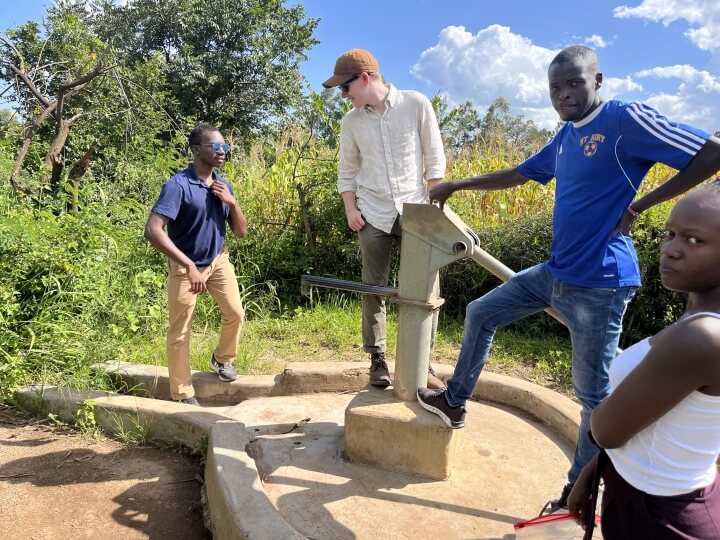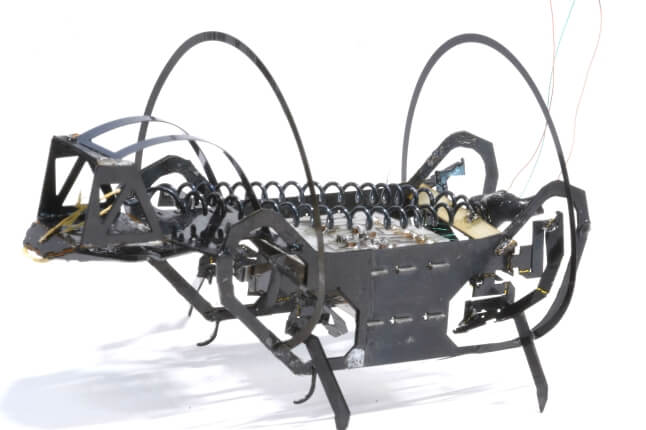News
Members of Harvard University Engineers Without Borders traveled to Kenya in June to continue the organization's ongoing project to construct wells in the Kibuon region. (Harvard EWB)
What happens when a group called “Engineers Without Borders” can’t cross borders due to a global pandemic?
The Harvard EWB chapter spent much of the last two years answering that question, focusing on remote design and implementation of its ongoing water infrastructure projects in Kenya and the Dominican Republic.
“We’d plan a trip for the next summer or winter, and it’d get delayed,” said Layla Seaver, co-president of Harvard EWB and a third-year environmental science and engineering student at the Harvard John A. Paulson School of Engineering and Applied Sciences (SEAS). “That was really difficult because a lot of our work is gauging how the community feels, getting updates on what they’d like to be different, and having frequent check-ins. Having that be purely virtual is very hard for both sides. We were able to do a lot of it remotely by hiring contractors and getting community involvement, but everything got so delayed, and the scope of our work had to change.”
Travel restrictions finally relaxed enough for members of Harvard EWB to visit Kenya in June to conduct surveys about water needs, inspect wells that had already been drilled, and evaluate potential new well sites. The team consisted of third-year students Alex Dyer and Giovan McKnight, who co-led the project, former project lead Marta Pawluczuk, faculty advisor Chris Lombardo and two students from the University of Nairobi.
All six lived together in the Kibuon region of Kenya. They began their days as early as 7:30 a.m. with a team breakfast of warm chapati, beans and corn before heading out to conduct household surveys, water quality tests, and potential well-site surveying. Most days, they would be welcomed into the home of a community member for lunch before continuing their work.
“It was great to get a 360-degree, in-person view of the well sites, but we also got to see how the communities were arranged in terms of population densities,” said McKnight, a third-year chemistry student. “It was nice to visit people from every region and see the socioeconomic differences. Mapping out all those differences allowed us to figure out which communities had the most need, and how we could best serve the four communities.”
Members of Harvard Engineers Without Borders meets with the Kibuon community-based organization during their June trip to Kenya. (Harvard EWB)
Finally getting to meet members of the Kibuon communities in person and experience day-to-day life in the region also allowed the team to understand the needs of different communities and learn how life changed there since the pandemic began.
“It was really interesting hearing from the community that during COVID, public health measures caused people to wash their hands more often, which put more demand on water and strained existing infrastructure,” Dyer said. “That’s a unique cascade of connections that’s really impacted how I view design decisions. It’s very easy to make things in isolation from each other. But there are always consequences that can result from that, which is really interesting.”
Harvard EWB is both a student organization and associated with a class, ES105HFR: Humanitarian Design Projects. Students are encouraged to take multiple semesters of the course, which meets twice a week and is taught by Lombardo, Associate Director of Undergraduate Studies in Electrical Engineering and Mechanical Engineering at SEAS.
“It has been challenging for the students to stay engaged over the past two years,” Lombardo said. “This is especially true as none of the current students were present for our last trip in 2019. The opportunity to visit Kibuon, see the impact of their work, and forge in-person relationships is instrumental to the success of future projects in the community.”
Dyer and McKnight joined EWB as first-year students, McKnight joining Lombardo’s class in the spring and Dyer following suit for the fall of his second year. Both wanted a class that favored practical application and implementation over theoretical engineering problem sets.
“Engineering is an applied science, so any opportunity, whether in extracurriculars or classes, to get involved in that application is really wonderful,” Dyer said. “Infrastructure not only integrates engineering principles, but it’s also very community oriented. EWB is a partnership between communities, so it’s not just us making decisions.”
Alex Dyer, center, inspects a well during the Harvard Engineers Without Borders trip to Kenya in June. (Harvard EWB)
The desire to use their engineering education for humanitarian purposes is a driving force for Harvard EWB’s leaders. For Dyer, seeing that direct impact in person in Kenya not only underscored why he wanted to join in the first place, but also changed the way he thought about infrastructure in the United States.
“A lot of our utility infrastructure is underground, so we don’t interface with it day to day,” he said. “Exposing a lot of these hidden things that we live our lives without thinking about until they’re gone was a huge thing for me. It’s given me a real appreciation for engineering.”
Harvard EWB’s other active project began in 2016 in Los Sanchez, Dominican Republic. That group, co-led by Billy Beauregard and Dania Villafuerte, has already completed its work for two of the three sections of the community, drilled its third borehole in January 2020 and is now focused on water storage and distribution to homes.
“We’re designing systems that will actually be put in place for these communities that wouldn’t otherwise be possible,” said Beauregard, a fourth-year studying environmental science and engineering. “A lot of the data had been collected on previous trips, but recently we’ve been focusing on the design of the first of two water storage tanks, and the preliminary design of the water distribution system. It’s a lot of work with CAD and hydraulic modeling software.”
The Los Sanchez team was set to travel to the Dominican Republic last winter but had to cancel the trip as COVID-19 infection rates spiked due to the Omicron variant. If no similar wave occurs this winter, the group could finally get to see their work in action in January.
“It’s very motivating to see the impact,” said Yasmine Omri, chapter co-president and a third-year electrical engineering student. “It’s great that we’re finally able to pick up the pace and connect with the community on a more personal level, and I think it will make a big difference in how we approach our projects.”
The Harvard EWB student leadership team takes on multiple responsibilities throughout the year. McKnight and Dyer create weekly assignments for group members and organize remote conversations with contractors and community leaders in Kenya, and Beauregard and Villafuerte do the same for the Los Sanchez group. Omri and Seaver coordinate communications between the projects and fundraising teams, organize daily board meetings and plan community-building and social events.
“It’s been my most rewarding experience at Harvard,” Seaver said. “This is one of my favorite things to do here. It’s so worthwhile.”
Topics: Materials Science & Mechanical Engineering, Student Organizations
Cutting-edge science delivered direct to your inbox.
Join the Harvard SEAS mailing list.
Press Contact
Matt Goisman | mgoisman@g.harvard.edu





